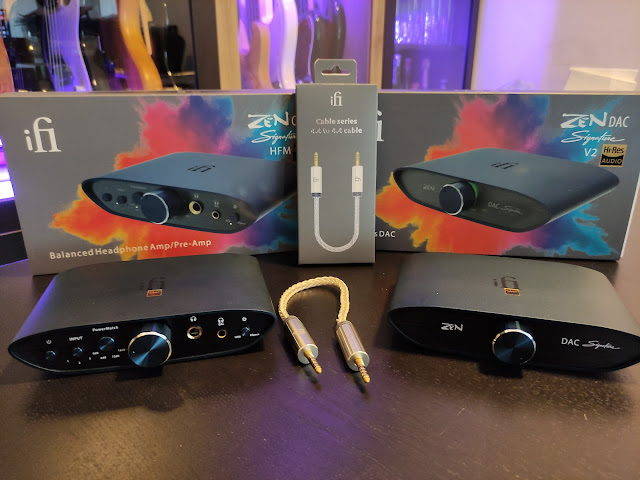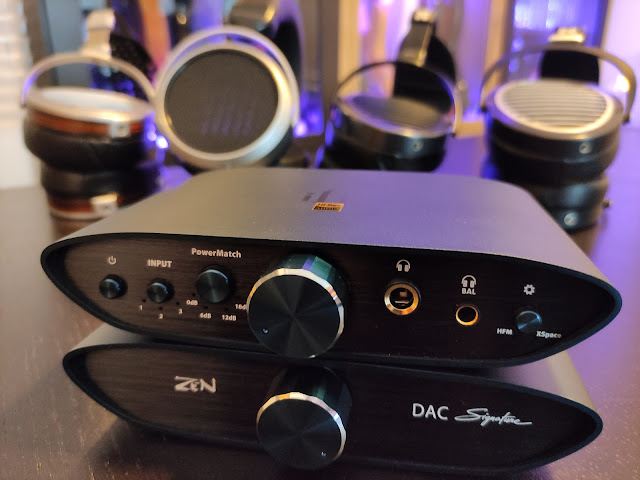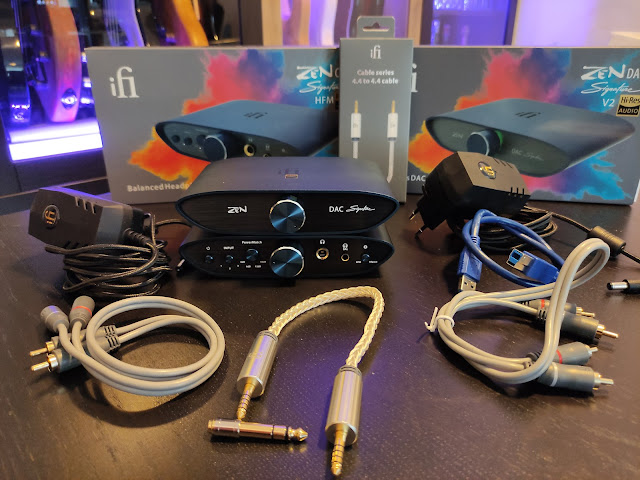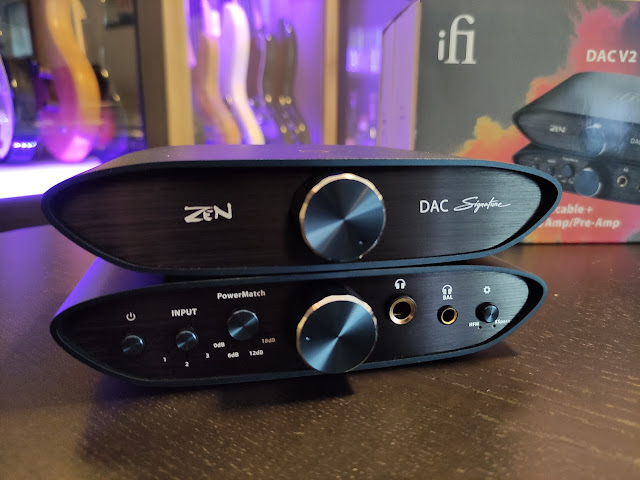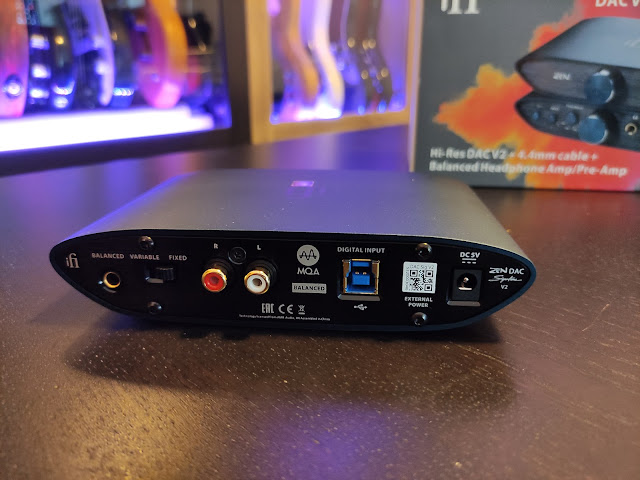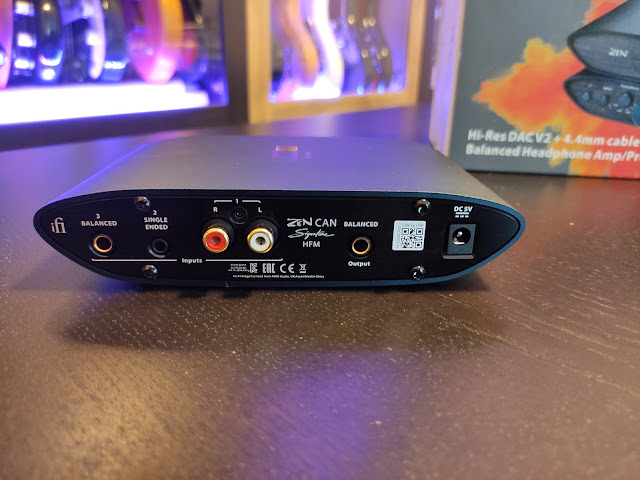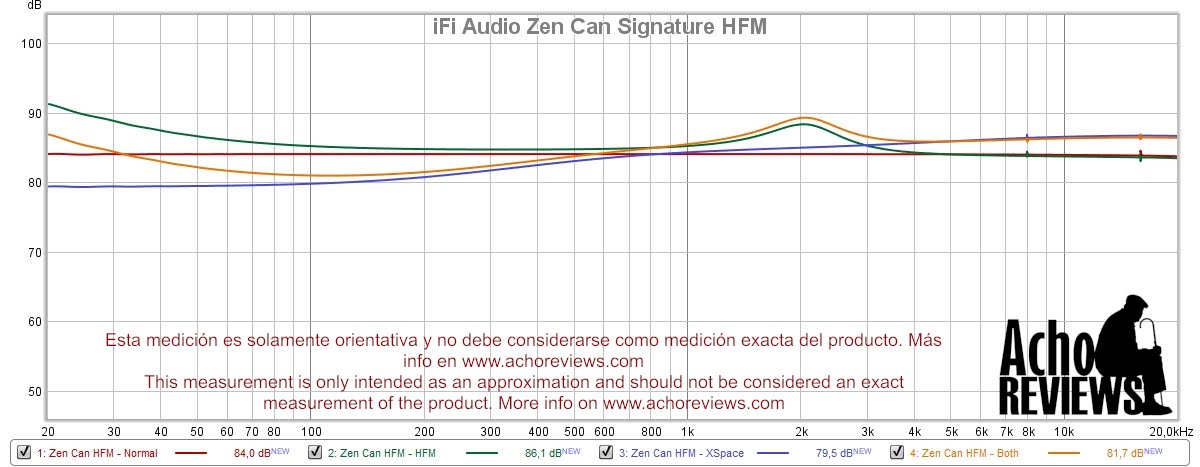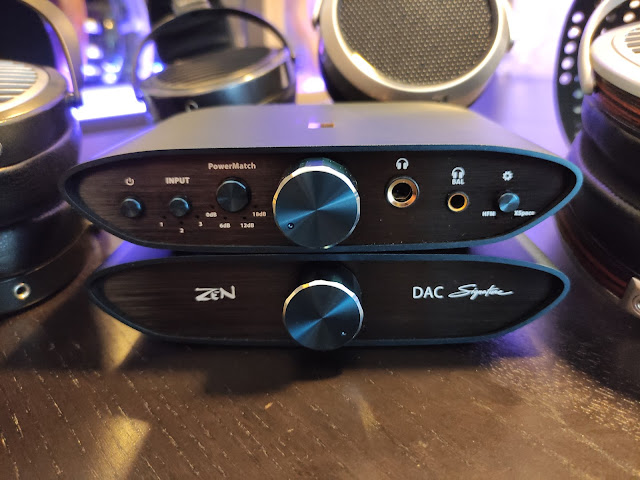Review - iFi Audio Zen DAC Signature v2 + Zen CAN Signature HFM
As always, this is also available in Spanish on my blog and on Youtube, links at the end of the post.
As a fan of Hifiman headphones, I was interested in trying out the new iFi Audio Zen CAN Signature HFM, so I contacted DeCine, who are the official distributors of iFi Audio in Spain and they kindly sent me not just the Zen CAN but also the the Zen DAC Signature V2, which is available as a full package (more on that in a moment).
As DeCine do not sell the product directly to the public, iFi Audio is sold in Spain by various stores that are supplied by them, I do not have a direct link, so if you would like to know more about the iFi Audio package, you can check out the iFi Audio website directly here: ZEN Signature Set HFM by iFi audio - ZENtastic Trio. Both ZEN Signatures plus 4.4mm Pentaconn cable.
As always, my review and opinions will be as honest and unbiased as possible but it is always good to consider that it has not cost me anything to try out these products.
Intro…
The Zen Signature set includes the Zen DAC Signature V2, the Zen CAN Signature HFM and a 4.4mm to 4.4mm pentaconn cable to connect them together and make the most of their balanced connections. The same set is also available with the Zen CAN Signature 6XX, which was released previously and is aimed at being used with the Sennheiser HD6XX/650 series.
As this includes two separate devices, which can also be purchased separately, I wasn’t quite sure how to address this review, as I feel it is good to look at the devices separately and together as a set. Therefore, I will comment on the usual build and presentation on both but will divide the functionality into two separate devices.
Obviously there are many ways to combine these devices separately into my system, such as connecting just the DAC to any of my amps, or feeding the amp from any of my DACs, but in order to try and keep this review as short as possible, the sound impressions will be limited to using it as a set.
Presentation…
The presentation of the DAC is rather simple but still well packed. Inside the box, that shows an image of the DAC and various specs on the outside, we find the DAC, the iFi iPower 5v supply and a short RCA to RCA grey cable. Also included are the usual iFi user manuals and warranty cards.
As for the Zen CAN, the packaging is identical, with the contents also being the same except for the additional included 6.35mm to 3.5mm adapter which, by the way, is the same as the adapter included with other iFi products and something that I am quite fond of.
Build and aesthetics…
Again, the build is identical on both units. I have said before that I like the fact that iFi products are different enough in their aesthetics to easily stand out from other brands. This is something that many like and many don’t, obviously depending on personal tastes.
In the case of these two units, they follow the usual and well known shape found on all of the iFi Zen line products. This is again a look that many like and I’m sure there will be many that don’t. I personally like it, and in the case of the Signature series, they are of a dark blue colour which I find very elegant. I am not really one to stack items as all of my equipment lives in a rack, but I would have no issue placing the signature stack on my desk at home or in the office, I feel it looks elegant and modern at the same time.
As far as build quality, well, I have yet to see an iFi product that I didn’t think was great as far as build quality. These are no exception. Completely made of metal, with nice feeling knobs and buttons, they seem to be robust enough to not have to worry about them.
Zen DAC Signature v2 functionality…
The DAC is simple enough to be set and forget while offering the basic needed connections. There are no filters to dive into, no parameters to set, it is just a simple layout with balanced and unbalanced connections available.
On the front of the unit, we have a simple knob with an LED ring behind it. This is for controlling the output level of the DAC (which can also be set to “fixed” by a switch on the back) with the LED ring changing colour depending on the format of audio being fed to the unit. The DAC supports up to 384kHz OCM, 12.4MHz DSD and does MQA, if that is something that interests you.
On the back of the unit, from left to right we have:
Balanced 4.4mm output - For feeding a balanced amplifier of course.
Variable/Fixed switch - Allowing to set the DAC output to fixed and bypassing the front volume control.
RCA unbalanced output - For feeding an amplifier with a single ended connection.
USB input - This is a USB 3.0 Type B plug, for connecting the DAC to a PC (or other USB device).
Power input - This is for the included 5v power supply (the unit can also be powered via USB if preferred).
As you can see, this is a rather simple DAC, it has only one digital input (USB) and offers unbalanced and balanced outputs, although we do get the variable and fixed options which are nice to have, especially if being used to feed powered monitors etc.
I really like the DAC, I will mention more about sound in a moment, but I do have one issue that stops me from making this a part of my system, the lack of more digital inputs, more specifically optical in my case.
I would say that the majority of people just connect the DAC to a PC, which is no problem with this DAC, but in my case I have an audio system that runs via Optical and digital Coax. This means that my DACs are usually connected to my PCs via USB but also receive signals from other devices that run via optical and coaxial. I am sure that I am in a minority in this case but in my personal scenario, this is a feature that I really need on a DAC.
Other than that, I have absolutely no issues with the Zen DAC Signature v2, it is a nice small unit that sounds great (again, more on that in a moment).
Zen CAN Signature HFM functionality…
Now on to the amplifier, which does have a few more features than the DAC and is actually a very interesting little amp. As far as power, the specifications say 1600mW @32Ohms and 98mW @600 Ohms (unbalanced), with 1200mW @32 Ohms and 385mW @600 Ohms (balanced). These are very respectable numbers but are not the thing that makes this amplifier stand out.
Looking at the distributions, on the front panel we have (from left to right):
Power button - Yes, you guessed it, to turn it on and off.
Input button - To cycle through the 3 available inputs.
Power Match - Which is the iFi Audio name for gain, offering a choice of 0dB,+6dB,+12dB and +18dB.
Volume control - A nice knob that matched the DAC volume control.
6.35mm Headphone output - For unbalanced headphones.
4.4mm Headphone output - For balanced headphones.
HFM/XSpace Button - To activate or deactivate the two additional sound profiles.
Moving around to the rear of the unit we have (again from left to right):
4.4mm Balanced input - For feeding a balanced input into the amp.
3.5mm Single ended input - For feeding a single ended signal into the amp.
RCA input - For feeding a second unbalanced signal into the amplifier.
4.4mm Balanced output - For feeding a balanced signal to another external amplifier.
5v Power input - For powering the unit via the included PSU.
I really find the CAN to be simple to use and has plenty of options to tailor it to my needs, the 4 levels of gain are nice, although I really didn’t find the need to use the higher two except on the Arya and HE400se (which were both for commodity and not really necessary), but they are certainly good to have if you have hard to drive headphones.
I will speak more about the HFM and XSpace functions in the sound section next but I will say that when cycling through them (Off - HFM - XSpace - HFM+XSpace), the change from HFM+XSpace to off does cause a bit of a electrical clicking noise through IEMs. It is only an instant but is certainly noticeable. I very much doubt that this will cause any damage but these kinds of noises always make me clench my teeth when I hear them.
Sound…
Before going on to the part that is probably the most relevant, using these as a stack, I will touch briefly on the individual components.
The DAC I find to be very reminiscent of the other two iFi Audio DACs I have reviewed (the iDSD NEO and the Diablo). Now, it may be expectation bias on my part but I straight away found the sound (when feeding other amps) to be a little smoother than my other AKM and ESS based DACs. Again, it may all be in my mind, I am not about to do a blind test as I don’t listen to music blindly (unless I turn the lights off but then I already know what I am connected to), but I do find it to portray the iFi sound that is so commonly spoken about.
As for the CAN, I like it. In normal mode (without HFM or XSpace activated), which I will call FLAT, I actually find it to sound similar to the Asgard 3. It has a bit of warmth to it when compared to something like the Atom or 789. Again, this could again be my brain, but I find it to be a bit more of a relaxed listen than the more analytical options, making it a nice choice for extended listening periods, especially when listening to brighter headphones or music.
When activating the HFM mode or the XSpace mode, there is a clear change to the frequency response. This can be considered a fixed equalization by iFi and is something that I find works in certain situations and not in others.
The change in frequency response of the amplifier is as follows:
iFi are very proud to announce (on all their products) that they only perform these equalizations in the analog realm, no digital processing, and I am not sure if anything else changes other than the frequency response. I do not have a way of measuring such changes but I do find that the XSpace creates a sensation of openness that could be dependent upon those changes to frequency or something more. If so, it works well (in certain situations)
Now, moving on to using these as a stack and my opinions on sound when using various headphones and IEMs. This setup is obviously aimed at being used with Hifiman headphones, well, at least the Zen CAN Signature HFM is, but that does not mean that it is only to be used with the Hifiman brand, which is why I have played around with the sound using a variation of headphones, hopefully some of the will be relevant to you.
For IEMs, I have used the Moondrop Blessing 2:Dusk, the Moondrop Aria, the Audeze iSine LX, the Hifiman RE600v2 and a selection of budget offerings which I am not going to specify as it was just more of a general listen.
For headphones, I have obviously focused on Hifiman, using the HE400se, Ananda, Arya and HE1000se, but I have also tried out the Sendy Peacock, Beyerdynamic DT1990 Pro, Sennheiser HD6XX and a few other models which, as with some other budget IEMs, which I am not going to go into detail on due to them being just brief general listens (I only have so much time!).
So, starting off with the IEMs, I find that the sound qualities seem to stay consistent, to some extent, independently of the IEMs used, except for the iSine LX. In general, I find that the amp works well with IEMs in the FLAT setting but when activating the XSpace, it opens up the top end and actually gives the IEMs more sensation of space and seems to improve the soundstage.
Now, having looked at the graphs above, we know what the CAN is doing to the treble region and I find that this little extra up top works well with the majority of IEMs I own. This is mainly due to the fact that almost all of the IEMs I have present some roll off in the high end for my tastes, especially the single dynamic driver models. The small boost from the CAN counteracts this slightly and helps those higher regions to stay a little more present. This can obviously be done also with any onboard EQ in your music player of choice, which is something I have done plenty in the past. However, while the onboard EQ does increase the treble, it doesn’t give the sensation of additional space that the CAN manages to provide. I don’t know if this is due to the analog nature of the iFi equalization or if there is something else going on inside. I will say that I own a few analog equalizers and I haven’t really experienced the spaciousness with those either.
Obviously, again looking at the graphs, the additional higher range presence does come at the expense of some low end. Now, as you probably already know if you have followed my reviews, I am a fan of neutral bass and many of the IEMs I have tried do have a little more bass than I really need (although none of them are too boosted for me not to enjoy them). This reduction of bass is something that I found I didn’t miss too much on things like the Dusk or the Aria, however, other more neutral sets like the RE600v2 do start to lack enough bass for my personal tastes, so probably would be considered to be lacking bass for the majority of listeners. This can be overcome on the RE600v2 by adding the HFM button, therefore running the CAN in HFM+XSpace mode, but on the majority of my IEMs, I found this to make them far too V shaped for my liking and the 2kHz bump from the HFM mode just didn’t work great with many of them.
So, my opinion would be that the CAN works well for IEMs, my preference being to run XSpace ON with IEMs that have enough bass to not become anemic, and stick to running FLAT with those that do. All in all, I like the CAN with IEMs.
Moving on to headphones, these seem to vary much more from set to set, some sounding better flat, others better with the HFM engaged, but there are very few moments I actually enjoyed the XSPace ON with headphones, especially open back planars.
As this is a Hifiman related setup, or at least the CAN is, I will focus on the various Hifiman models a little more in depth but first let me mention the other few headphones I used from other brands.
In the case of the DT1990 Pro, I found that I liked to run these with the CAN set to flat. These headphones already have great bass, they don’t need the bass interfering with, and I certainly wouldn’t suggest adding any extra high frequencies to the DT1990. With the amp set to FLAT, the DT1990 Pro did its usual trick of sounding like the DT1990 Pro. I really do think that these are the least amp dependent headphones I own.
With the Sennheiser HD6XX, these are already warm headphones and, although that warmth is located in the lower mids and higher bass regions, I really didn’t feel that the HFM button did anything to help them out, it just made them seem a little bloaty and took away some of the magic in the mid range that these have (when I am in the right mood  ). I felt that the XSpace did open them up a little at the top end but not enough for me to actually rave about it, it didn’t do anything that I can’t already do with a little tweaking in any EQ software.
). I felt that the XSpace did open them up a little at the top end but not enough for me to actually rave about it, it didn’t do anything that I can’t already do with a little tweaking in any EQ software.
I am not going to mention the Sendy Peacock as I haven’t actually posted a review of it yet (coming soon), so I will keep my impressions of it to myself until then. A couple of other headphones that I tried were nothing that really deserve in depth descriptions, they sounded similar to listening to them on my Asgard 3.
So, on to Hifiman…
First up, let’s start with the HE400se, a very budget orientated planar magnetic headphone that I am quite a fan of. I find that these headphones do get better as the source improves but are not something that needs a huge amplifier and expensive DAC to enjoy. These are actually the only headphones, together with the Arya, that I opted for +12dB gain on.
The FLAT mode works very well for the HE400se but I found that the HFM option did give these headphones a better all round sound. Using my test list and swapping between FLAT and HFM, I just kept preferring the HFM engaged. It added a fullness to the lower end but without seeming to be too much. It also gave the vocals a little push forwards and became a set of headphones that I enjoyed even more than I usually do.
I didn’t really feel that the XSpace added anything that I really noticed as an improvement, with or without HFM mode engaged, so I kept going back to the simple low end and vocal improvement I got with HFM. I would say that the HE400se with the HFM engaged are a great set of headphones to kick back, relax and enjoy many of my favourite tracks, especially in simple acoustic tracks or even electric guitar based tracks like some of the Tracy Chapman stuff etc.
Moving up to the Ananda, a set of headphones that I love the “directness” of and, although I have listened to headphones since that I feel are better for relaxed listening sessions, I could still be quite happy with the Ananda as my main headphone.
I again found that FLAT worked well but I didn’t quite enjoy them as much as I do with the Asgard 3. I also didn’t find that I enjoyed the HFM button on the Ananda, except for a few tracks. With the majority of the music I listen to, I much prefer the Ananda set to FLAT rather than with any of the alternative modes activated.
The tracks where the HFM improved the sound was more due to the actual recording than the headphones, and is something that I would usually just EQ on the fly if listening to those specific albums.
The next set are the Arya, which I like but find are sometimes overly spacious for my personal tastes. Don’t get me wrong these are great headphones, they are just not something I feel like I could listen to all the time. These were another set of headphones that I opted for the 3rd gain setting on.
I actually found that these headphones I enjoyed quite a bit with both the HFM and XSpace activated. Now, I just said that the Arya are a little too spacious at times for my liking, so I would have thought that the XSpace would push this even further away from my preferences but somehow it didn’t. It’s not all positive though, the extra treble brought by the XSpace function does bring some more presence to the higher range but at the same time it increases the harshness that is sometimes found in the Arya with certain tracks.
However, the HFM button for these seems to be perfectly placed, that 2k bump works wonders to bring back the top end of voices that I feel is the strange part of the Arya. It also doesn’t suffer from that bit of extra bass that this setting brings.
I kept swapping between FLAT and HFM+XSpace (I didn’t feel like XSpace brought anything great individually) and I really liked the latter when the music was not harsh. It was strange listening to the Arya with this slight “V” shaped tuning (well, not really “V” shaped) but it grew on me very quickly, I thought “No Sanctuary Here” was great! The problem was when I moved to some of my acoustic music, the vocals could become harsh if the voice and/or recording wasn’t slightly tamed in the upper ranges. This was easily fixed by just going back to HFM mode only.
The good thing is that it is very easy to switch from HFM+XSpace back to FLAT and to HFM whenever a track calls for it. I must say that the Arya are probably the headphones that most surprised me on the Signature stack (with the HE400se being close behind). I think I could spend a lot more time with these headphones using the CAN.
Finally, the HE1000se, the headphones that I drool over when listening to and could quite easily become my only set of headphones, if it wasn’t for the price. Up to this moment, I have to say that the HE1000se are the best sounding headphones I have heard and I think it is very difficult to improve on how good these are.
I’m afraid that my sensation was correct, I didn’t find that either the HFM or the XSpace did anything to improve the sound over running these FLAT. However, running these FLAT did result in the same amazing sound that I hear each time I place these headphones on my head. I did go back and forth between the CAN (set to FLAT) and the Asgard 3 and decided that it was so close that I finally gave up and just listened to music. I see that as a very positive thing for the CAN as I am a big fan of the Asgard and moving over to the CAN did not do anything to detract from the enjoyment I get from these headphones.
Conclusion…
Both of the products, both the DAC and the CAN, are very good in my opinion. The DAC itself is simple but the sound quality is great and I think that if you are looking for a DAC and you only need USB inputs, this is a great choice. It certainly has, to me, that iFi sound and is also a great way to experience that iFi sound at a very reasonable price. If you want to be able to play with filters and have plenty of options, then this DAC isn’t for you, but if you want a simple, no frills, good sounding DAC, it is worth a try.
As far as the CAN, or more specifically the Zen CAN Signature HFM, well, it brings quite a lot to the table for its price. It has the inputs and outputs to cover most need, unless you need an unbalanced preamp, in which case it doesn’t fit the bill. As far as sound, it sounds great as it is (FLAT) and reminds me of the Asgard 3 in some ways, it has a relaxed nature to it, although maybe not quite as rounded as the Asgard.
The 4 levels of gain should be enough to cover the needs of most headphones, unless we are talking about very power hungry sets. I personally don’t have anything that needs huge amounts of power, such as the HE6, but I am guessing that +18dB gain is more than enough for most users.
The HFM and the XSpace buttons are something that many may see as a gimmick, but they do allow you to tweak the sound to your preferences with each headphone, at least in general. No, it is not a 10 band PEQ that will allow you to fine tune your headphones, it is a simple boost that can increase the low end, add some extra air, bring vocals forward or just combine all of these, whatever your preferences would be. Would I recommend this over running PEQ, well that depends on how much you actually dedicate yourself to EQ. If you are someone who spends time to get EQ right, then of course not, but if you are like many who don’t understand (or just don’t want to) EQ, then these give you an extra 3 sound signatures at the press of a button. I think of it like the typical presents found on many consumer grade units but with better implementation, more thought and done in the analog realm. This doesn’t mean it will work well for everyone, or for every headphone, or even for every song, but to turn it on or off takes less than a second.
I really enjoyed my time with this iFi set, both because it is good and because I got to spend all week using headphones that I don’t get to listen to as much as I would like to. Although I really don’t like reviewing amps and DACs because I am never sure what is real and what I am imagining I hear, it does give me a chance to pull out headphones and IEMs that I like but don’t get to use very often.
Would I purchase either of them?
Well, yes and no. As far as quality and sound, yes, without a doubt, I feel they are great units at a very reasonable price for an iFi product. However, my personal use case is slightly different to that of the majority and I don’t think they would get the use they deserve in my setup. If I wasn’t reviewing stuff and constantly changing, I would love the Signature set for my desk at work, as it looks good and sounds good.
I am sorry that this review has become such a long one, however, there were many things to try and I wanted to share (most of) them with you.
